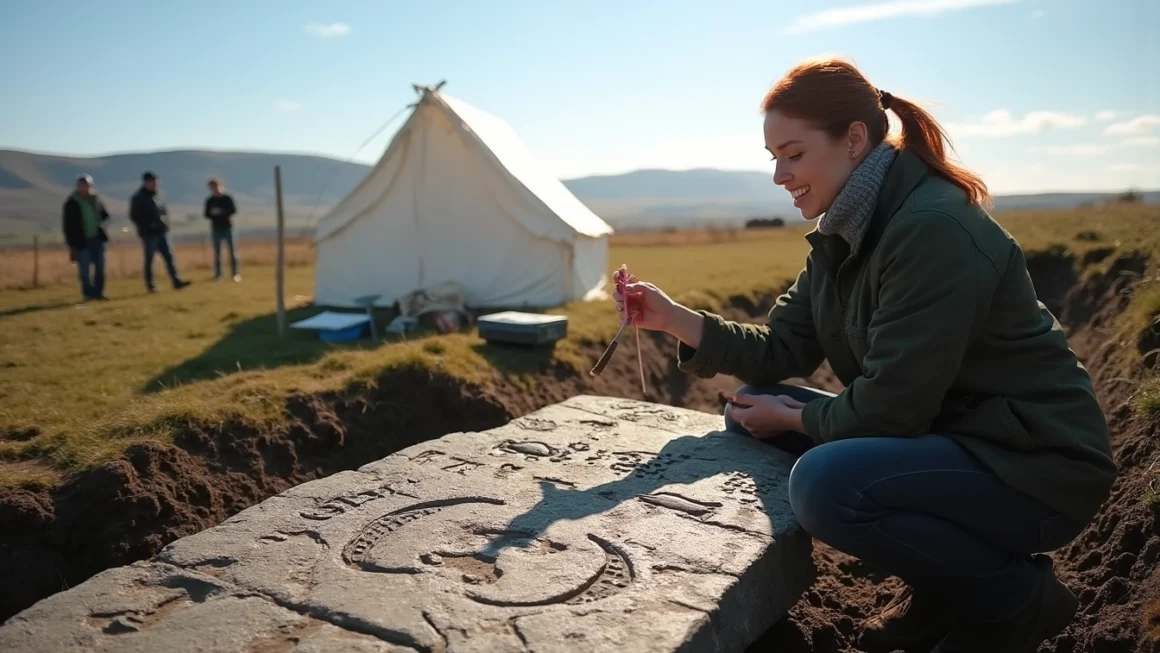Unraveling the Mystery: Ancient Carvings in Scotland
Table of Contents
In a fascinating discovery that has captivated archaeologists and history enthusiasts alike, ancient carvings have been unearthed in Scotland, shedding new light on the region’s rich past. These intricate engravings, found on a stone slab in Aberdeenshire, are believed to date back to the Pictish period, offering a rare glimpse into the artistic and cultural practices of our ancestors.
The Remarkable Find
The stone, which measures approximately 1.7m in length, was discovered during excavation work at a farm near Rhynie. What makes this find particularly exciting is the exceptional preservation of the carvings, which depict a range of symbols including animals, geometric patterns, and possibly human figures.
Experts from the University of Aberdeen, who are leading the research, have described the discovery as “one of the most significant Pictish finds in recent years.” The clarity and complexity of the engravings provide valuable insights into the craftsmanship and symbolism of the Pictish people, who inhabited northern Scotland from the late Iron Age to the early medieval period.
Decoding Ancient Symbols
The carvings on the stone slab present a unique challenge to researchers. While some symbols are recognizable, others remain enigmatic, prompting intense speculation and study. Among the identifiable figures are:
- A crescent and V-rod symbol, commonly found in Pictish art
- Animal representations, possibly including a deer or horse
- Intricate geometric patterns that may have held spiritual or cultural significance
Archaeologists are working diligently to interpret these symbols, hoping to unlock the secrets of Pictish communication and belief systems. This process involves comparing the newfound carvings with other known Pictish stones and artifacts, as well as consulting historical records and folklore.
The Significance of Rhynie
The location of this discovery is notable in itself. Rhynie has long been recognized as an important Pictish center, with several significant finds unearthed in the area over the years. This latest discovery adds another piece to the puzzle, helping to build a more comprehensive picture of Pictish society in this region.
The site where the stone was found is believed to have been a high-status settlement, possibly a royal or religious center. This context adds weight to the importance of the carved stone, suggesting it may have played a crucial role in Pictish ceremonies or governance.
Preservation and Future Research
With such a significant find, the focus now turns to preservation and further study. The stone has been carefully removed from the site and transported to a specialized facility where it will undergo detailed analysis and conservation treatment.
Advanced imaging techniques, including 3D scanning and multispectral imaging, will be employed to reveal any hidden details and to create a permanent digital record of the carvings. This technology not only aids in preservation but also allows for wider access to the artifact for researchers around the world.
Implications for Our Understanding of Scottish History
The discovery of this carved stone has far-reaching implications for our understanding of Scottish history and Pictish culture. It provides tangible evidence of the artistic and technological capabilities of these ancient people, challenging preconceptions about prehistoric societies in Scotland.
Furthermore, the symbols and motifs found on the stone may help to bridge gaps in our knowledge of Pictish language and writing systems. While the Picts are known to have had a form of written communication, much of it remains undeciphered. Each new discovery brings us closer to cracking this ancient code.
Community Engagement and Heritage
This remarkable find has sparked considerable interest among the local community and beyond. Plans are underway to involve the public in the research process through exhibitions, lectures, and potentially citizen science projects. Such engagement not only fosters a sense of connection to Scotland’s rich heritage but also helps to ensure the preservation and study of archaeological sites for future generations.
In an era where automation and technology are rapidly changing our world, discoveries like this remind us of the importance of preserving and understanding our past. Tools like Make.com can help streamline the documentation and analysis processes in archaeological research, allowing experts to focus more on interpretation and conservation efforts.
Looking to the Future
As research continues on this remarkable artifact, it’s clear that its impact will be felt for years to come. The carved stone from Rhynie not only provides a window into Scotland’s ancient past but also serves as a testament to the enduring human desire to create, communicate, and leave a lasting legacy.
The discovery serves as a powerful reminder of the secrets that still lie buried beneath our feet, waiting to be uncovered. It underscores the importance of continued archaeological work and the need for careful stewardship of our historical sites.
As we move forward, balancing the preservation of our heritage with the demands of modern development will be crucial. The Rhynie stone stands as a bridge between past and present, inviting us to reflect on our shared history and the enduring mysteries of human civilization.




